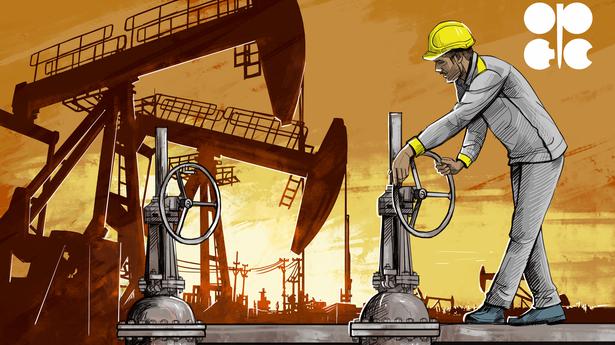
Opec Plus | The cartel and its allies that keep oil on the boil
The Hindu
As energy prices rise amid crippling sanctions against Russia, OPEC and its partners are under pressure to stabilise the market
OPEC Plus countries, an alliance between the Organization of the Petroleum Exporting Countries and other major oil producers, are in the limelight as global oil prices soared above $120 a barrel last week as supplies failed to keep up with rising demand. The price of oil is expected to remain elevated for some time to come after the European Union decided last week to cut down oil imports from Russia by 90% by the end of this year and block European insurers from selling cover to tankers carrying Russian oil. The move is expected to worsen the present oil supply crunch as non-Russian oil producers may not be able to compensate for the lost Russian supplies and meet the EU’s demand for oil within a short span of time.
Under pressure from major oil importers, OPEC Plus last week agreed to raise production by 6,48,000 barrels a day in July and August, a jump of about 50% over the monthly increase set last year under a deal. OPEC Plus countries, which control more than 50% of the world’s crude supplies, had joined hands to cut down oil production by 10 million barrels a day in 2020. The decision was taken amid falling oil prices as demand for oil fell drastically due to COVID-19 lockdowns across the world. It is feared that as the global economy gets back on its feet, the failure of OPEC Plus countries to increase output quickly enough to pre-pandemic levels could cause oil prices to stay high.
OPEC Plus refers to a group of 23 oil-producing countries that includes 13 members of OPEC (Saudi Arabia, the UAE, Iran, Iraq, Kuwait, Algeria, Angola, Equatorial Guinea, Gabon, Libya, Nigeria, the Republic of the Congo, and Venezuela) and 10 other oil-producing countries (Russia, Azerbaijan, Bahrain, Brunei, Kazakhstan, Malaysia, Mexico, Oman, South Sudan and Sudan). Saudi Arabia is the largest oil producer among OPEC members. Russia, which produces more oil than even Saudi Arabia, plays a crucial role, along with OPEC, in influencing global crude oil prices.
It should be noted that OPEC Plus was created in 2016 when OPEC countries decided to ally with other oil-producing countries outside the group to cut down the global output of oil. Under the pact, called the Declaration of Cooperation (DoC), the countries have worked together to influence global energy prices. To institutionalise the cooperation further, OPEC countries and their allies, in a ministerial meeting held on July 2, 2019, accepted a ‘Charter of Cooperation’. “The Charter provides a platform to facilitate dialogue and exchange views regarding conditions and developments in the global oil and energy markets. The goal is to contribute to a secure energy supply and lasting stability for the benefit of producers, consumers, investors and the global economy,” according to the OPEC website.
The new grouping was seen as a response by oil-producing countries to protect their interests amid the rise of the U.S. shale industry. U.S. shale oil producers had caused a steep drop in the price of oil by massively increasing U.S. energy supplies and put the finances of OPEC governments under a lot of strain. OPEC itself was formed in 1960 as a cartel to influence the global price of crude oil. The global energy market was largely dominated by western multinational companies, called the ‘Seven Sisters’— Anglo-Iranian Oil Company (now BP), Royal Dutch Shell (now Shell), Standard Oil Company of California (later Chevron), Gulf Oil (now merged into Chevron), Texaco (now merged into Chevron), Standard Oil Company of New Jersey-Esso (now part of ExxonMobil) and Standard Oil Company of New York-Socony (now part of ExxonMobil).
In September 1960, Iran, Iraq, Kuwait, Saudi Arabia and Venezuela convened in Baghdad to discuss ways to pump up prices, which led to the formation of the cartel. “OPEC developed its collective vision, set up its objectives and established its Secretariat, first in Geneva and then, in 1965, in Vienna. It adopted a ‘Declaratory Statement of Petroleum Policy in Member Countries’ in 1968, which emphasised the inalienable right of all countries to exercise permanent sovereignty over their natural resources in the interest of their national development,” according to the OPEC site. The “oil shock” of 1973, which led to a doubling of the price of oil within a couple of years and contributed to stagflation in the U.S. which was marked by rapidly rising prices and faltering economic growth, was the result of an OPEC embargo, which also showed the cartel’s economic might.
Members of the cartel meet every month to decide the amount of oil they pump into the global market. According to current estimates, 79.4% of the world’s proven oil reserves are located in OPEC countries, mostly in West Asia. OPEC members produced about 37.1% of the world’s total crude oil in 2020.













